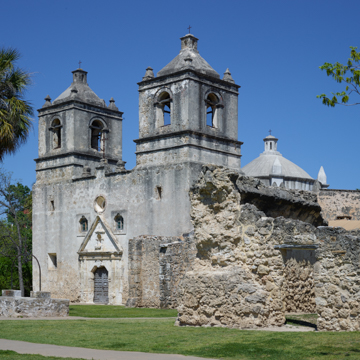The first of the four missions encountered along the route, and the least altered by reconstruction, Mission Concepción remains an active parish church. The church today presents a much more austere appearance than it had in the 1700s when the stuccoed facade was painted with a pattern of quatrefoil panels with trompe l'oeil quoins at the corners of the towers. All of this decorative painting was gone by the mid-nineteenth century. The most distinctive features of the church are the twin bell towers capped by pyramidal roofs, the only such configuration to be completed on any of the San Antonio mission churches.
In contrast to the plainness of the facade is the detailing around the entrance, consisting of a pair of engaged columns supporting a steep pediment. The elaborate niche in the pediment originally housed a statue of the Virgin Mary. The polylobed arch above the door may have been inspired by the arches of the Basilica of Guadalupe (1695–1709) near Mexico City. Triangular panels on each side of the arch are significant for their iconographic sculpture. The medallion to the left of the arch shows the crossed arms of Christ and St. Francis, while the medallion to the right shows the five wounds, or stigmata, inflicted on Christ while on the cross. The knotted rope that winds around these medallions refers to the knotted cords used as belts by members of the Franciscan order, who originally staffed the mission. The inscription along the face of the arch reads, “With these arms, this mission attends to her patron and princess and defends the state of her purity,” a reference to the Virgin as patron. The nave vault and the low dome above the crossing of the church, which rests on an octagonal drum, are covered by white plaster.
The interior of the church contains some original wall paintings. The most elaborate, located in the small room to the right upon entering the church, shows the crucifixion of Christ. Just below this scene, which is faded and damaged, is a stone font. Its carved decoration again includes the knotted cord of the Franciscan order. Other interior features of note are the trefoil arch and staircase of the infirmary and the shell window in that room, and additional decorative painting in the baptistery.
The partially ruined structure to the right of the church is the convent, which houses interpretive exhibits on the site.









